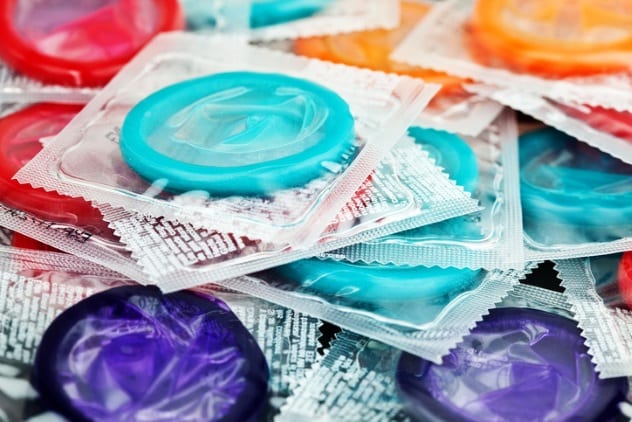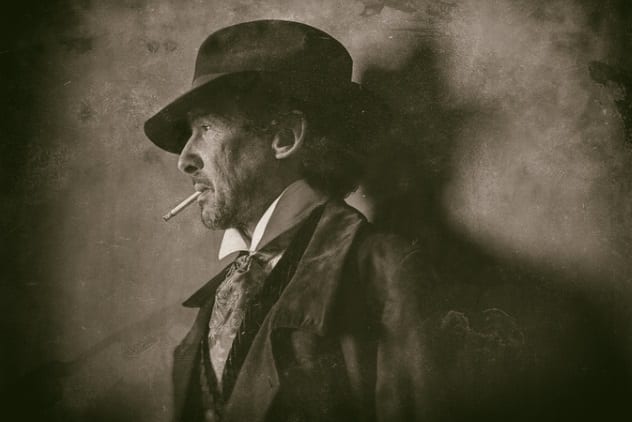 Weird Stuff
Weird Stuff  Weird Stuff
Weird Stuff  Animals
Animals 10 Inspiring Tales of Horses Being Human
 Mysteries
Mysteries Top 10 Haunting Facts About the Ghost Ship MV Alta
 History
History 10 Surprising Stories About the Texas Rangers
 Humans
Humans 10 Philosophers Who Were Driven Mad by Their Own Theories
 Miscellaneous
Miscellaneous 10 Video-Game-Worthy Weapons and Armors from History
 Weird Stuff
Weird Stuff 10 Psychics Who Accurately Predicted Wartime Events
 The Arts
The Arts 10 Pieces of Art Inspired by a Broken Heart
 Health
Health 10 Science Fiction-Sounding New Medical Treatments
 History
History 10 Surprising Facts About the Father of Submarine Warfare
 Weird Stuff
Weird Stuff 10 Times Real Laws Were Based on Bizarre Hypotheticals
 Animals
Animals 10 Inspiring Tales of Horses Being Human
 Mysteries
Mysteries Top 10 Haunting Facts About the Ghost Ship MV Alta
Who's Behind Listverse?

Jamie Frater
Head Editor
Jamie founded Listverse due to an insatiable desire to share fascinating, obscure, and bizarre facts. He has been a guest speaker on numerous national radio and television stations and is a five time published author.
More About Us History
History 10 Surprising Stories About the Texas Rangers
 Humans
Humans 10 Philosophers Who Were Driven Mad by Their Own Theories
 Miscellaneous
Miscellaneous 10 Video-Game-Worthy Weapons and Armors from History
 Weird Stuff
Weird Stuff 10 Psychics Who Accurately Predicted Wartime Events
 The Arts
The Arts 10 Pieces of Art Inspired by a Broken Heart
 Health
Health 10 Science Fiction-Sounding New Medical Treatments
 History
History 10 Surprising Facts About the Father of Submarine Warfare
10 Unbelievable Things That Have Required A Doctor’s Prescription
Doctors are certainly known for issuing drug prescriptions. However, depending on the country, state, or city, they could also write prescriptions for other things. Most of these surprising prescription items are downright weird, since they usually shouldn’t require a prescription.
In most instances, people were left unable to get their hands on the following things unless they had a doctor’s prescription. Some of the following items are still prescription-only today. Here are ten things you might never have guessed were once prescribed by doctors.
10 Sex Toys

A doctor’s prescription was once required to buy a sex toy in the city of Sandy Springs, Georgia, in the United States. The ban on sex toys was dictated under a city ordinance outlawing the buying or selling of “any device designed or marketed as useful primarily for the stimulation of human genital organs.”
However, the city permitted the sales and use of sex toys only if they were for “bona fide medical, scientific, educational, legislative, judicial, or law enforcement purposes.” While the law did not explain how a sex toy could be useful for judicial and law enforcement purposes, it demanded that anyone requiring a sex toy for medical purposes have a doctor’s prescription.
Some residents challenged the legality of the ordinance in court. One was a woman who was left with nerve damage after suffering from multiple sclerosis. She said her sex life was negatively affected, and her marriage would have fallen apart if she had not used sex toys.
While she probably got her prescription to get the toy, she found it ridiculous that she needed to do so. Another plaintiff was an artist who uses sex toys for his artworks. He said he could not produce his art unless he got a doctor’s prescription for a sex toy.[1] In March 2017, the ban on sex toys was lifted.
9 Condoms

Need a condom in Ayala Alabang? You will need a medical prescription for that.[2] Ayala Alabang is one of the most expensive areas of the Philippines’ capital, Manila. It is also a religious battleground, with conservative Roman Catholics on one side and some liberal citizens on the other.
The majority of Filipinos are Roman Catholics, and Catholicism forbids the use of any form of artificial birth control, including condoms. This explains where the ordinance banning the sale of condoms came from.
The ban has divided opinions among Filipinos, for whom birth control remains a hotly debated topic. Some believe the government should be promoting birth control instead of suppressing it. Luckily for those worried about pregnancy or STDs, the prescription requirement is not strictly enforced.
8 Chewing Gum

Chewing gum has been banned in Singapore since 1992. While still enforced, the ban was relaxed in 2004 as part of trade discussions between Singapore and the United States. Under the agreement, Singapore approved the importation and sales of what it called “therapeutic gum.”
Those who want to obtain therapeutic gum (such as nicotine gum or gum marketed as beneficial for teeth) need a prescription and have to get it from a doctor or pharmacist. The gums are only sold in pharmacies for this reason.[3]
Getting a prescription and visiting the pharmacy is just one part of the hassle of getting therapeutic gum. Buyers are expected to provide their name and ID cards before the pharmacist can sell them gum. Any pharmacist who violates the rule could get a two-year jail sentence and a $2,940 fine.
7 Alcohol

In 1920, the United States passed the National Prohibition Act, outlawing the sale and production of alcohol. What followed was the emergence of what was called “medicinal alcohol.” Medicinal alcohol was the same as regular alcohol. The only difference was that a doctor’s prescription was required to buy it.
Medicinal alcohol was basically a creative attempt to work around Prohibition. Doctors prescribed it to cure real medical conditions like cancer and depression. It was a brisk business, with patients doling out $6–$7 for a prescription. The prescription lasted for ten days, so the patients always came back for another one.[4]Winston Churchill, the future prime minister of the United Kingdom, also got his own prescription for medicinal alcohol when he visited the US in 1931. Arriving in New York, Sir Churchill was hit by a car while exiting a cab. Not one to miss a good opportunity, he had his doctor write him a prescription for medicinal alcohol. The doctor prescribed a minimum of six shots of alcohol during every meal. There was no overdose, and Sir Churchill was allowed to stop drinking at his discretion.
6 Cigarettes

Years ago, it was absolutely normal for doctors to prescribe cigarettes to asthmatic patients. The cigarettes back then were not the regular ones we see today. They were nicotine-free versions containing anti-asthmatic compounds like stramonium. Tobacco cigarettes containing nicotine were becoming more popular at around the same time, and so were cannabis and opium cigarettes.
The anti-smoking campaign soon came around, and people became aware of the dangers of smoking. However, doctors ignored the negative effects of smoking and continued to focus on the health benefits of tobacco. Things changed after World War II, when users became wary of all forms of cigarettes. This led to the demise of asthmatic cigarettes.[5]
5 Female Condoms

Female condoms (aka internal condoms) have not been spared the doctor’s prescription in the United States. The only reason for this boils down to one thing: money. F2C is the only brand of internal condoms approved by the FDA for sale in the United States. Despite its monopoly, it suffered poor sales.
This was why its makers, Veru Health, switched to a prescription-only business model in 2017. Under this model, patients with F2C prescriptions would get it on their insurer’s bill, since it was included as one of the birth control methods in the Affordable Care Act (aka Obamacare). The insurers would then pay Veru Health for the condoms.
Veru Health’s change in business model was criticized. First, people without insurance needed to shell out about $20—up from $3.50—for the condoms. While Veru Health markets the condom as a female condom, men and women often use it during anal sex. The higher cost could discourage them from buying it, making them vulnerable to sexually transmitted infections.[6]
4 E-Cigarettes

E-cigarettes are among the latest controversial inventions out there. While manufacturers promote them as the solution to make people quit smoking, critics say they could actually cause non-smokers to start smoking. The fact that they often contain fruit flavoring could also make them appeal to children.
Public Health England (PHE), an agency under the UK’s Department of Health and Social Care, has proposed that e-cigarettes should only be sold with a medical prescription. That way, they will only be available to people attempting to quit smoking. PHE says e-cigarettes are less risky to people around the smoker and 95 percent less harmful than regular cigarettes. They also help 20,000 people quit smoking every year.
In 2016, the Medicines and Healthcare Products Regulatory Agency (MHRA) issued British American Tobacco a license to market an e-cigarette called E-Voke as a “smoking cessation aid.” This means that British doctors can actually prescribe E-Voke to people trying to quit smoking.[7]
3 Vibrators

At a time when female sexuality was poorly understood, it was absolutely normal for doctors to prescribe a pelvic massage to cure women of what they called hysteria. Women affected with hysteria were said to be restless, anxious, and easily irritated.
The “pelvic massage,” aka giving the woman an orgasm, was handled by a doctor. But the doctors found the task to be very demanding and unpleasurable. Dr. J. Mortimer Granville saved the day when he invented the vibrator in the 1880s. Though he originally designed the device to treat muscle pain, it soon found use for inducing “hysterical paroxyms.”
The vibrator (originally confined to medical facilities) was operated by a doctor to help women diagnosed with hysteria reach orgasm.[8] Inventors eventually came up with all sort of products, and women soon started buying them for personal use. Vibrators slowly made the transition from the doctor’s office to bedrooms, while cases of “hysteria” gradually reduced until finally disappearing. (Note that this account of the origin of the vibrator has been challenged as mythical by some.)
2 Chocolate

Chocolate has been used as a drug throughout history. The Aztecs used it to treat all sort of diseases and ailments, either as a standalone or by mixing it with other herbs, roots, and barks. In Europe, chocolate was considered a food and drug, and it was absolutely normal for doctors to prescribe it to treat diseases.
Sometimes, doctors mixed bitter and disgusting drugs with chocolate so that their patients would take them. Obviously, only few people will readily ingest a powder made from grounded-up earthworms. However, they had no qualms when it was mixed with chocolate.
Fraudsters soon infiltrated the chocolate market and started selling chocolate as an all-in-one cure for every disease under the Sun. While chocolate worked for some of the ailments, it was possible that it only did because users boiled it in water before drinking it. Boiling kills harmful organisms in water, making it safer.[9]
1 Heroin

Heroin is considered one of the worst hard drugs out there. Yet, doctors once considered it medicine and would often prescribe it to treat a number of ailments, including cough, tuberculosis, and pneumonia. It was even sold over the counter and was readily available in pharmacies. Parents would often buy heroin to administer to their children before bed.
Heroin was developed, manufactured, and sold by Bayer pharmaceutical company as a non-addictive replacement for morphine. Some doctors became wary of the true effects of the drug and voiced their concerns. However, their warnings were ignored until hospital wards got filled with patients addicted to heroin.
This forced Bayer to permanently suspend production in 1913. The US issued a partial ban in 1914, turning heroin into a prescription-only drug. This changed little, and heroin was delisted in 1920. Addicts found other sources for their heroin, and many turned to crime to fund the habit.
Today, heroin is illegal in most parts of the world. Believe it or not, though, some countries, including Germany, Switzerland, the Netherlands, the UK, and Canada, allow doctors to prescribe heroin as a last resort for addicts undergoing rehabilitation. The prescription is heavily regulated and will only be issued if nothing else works.[10]
Read more facts you may not have known about common items on 10 Everyday Accessories That Stopped Bullets and 10 Explosive Substances In Everyday Items.








